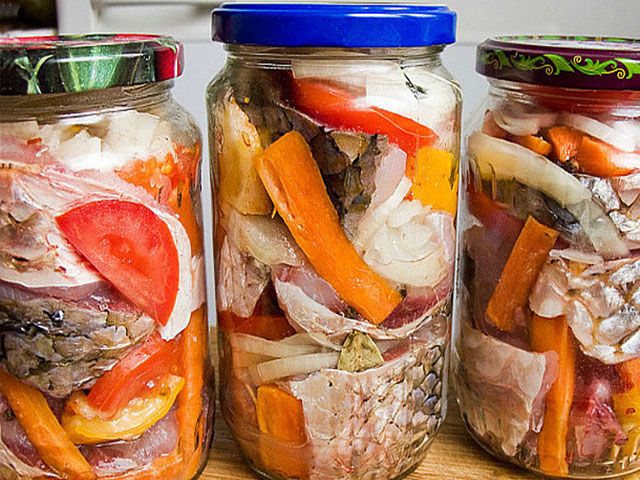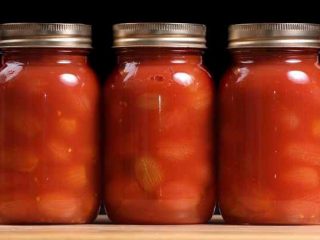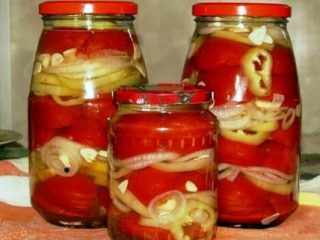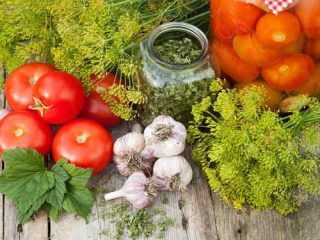Content
- 1 What kind of fish can you make home canned fish from?
- 2 How to properly preserve fish at home
- 3 Homemade canned fish in tomato
- 4 Homemade canned river fish in tomato
- 5 Canned fish for the winter from river fish
- 6 Canned fish in the oven
- 7 Preserving fish at home directly in jars
- 8 Home-canned fish with onions and carrots
- 9 How to preserve fish in oil
- 10 Canned fish for the winter with garlic and coriander
- 11 Canned fish for the winter from sardines
- 12 How to prepare canned fish with onions and celery for the winter
- 13 Small river fish in tomato for the winter in jars
- 14 Homemade canned fish in tomato with vegetables
- 15 Recipe for canned fish for the winter with spices
- 16 Canned fish in a slow cooker for the winter
- 17 Rules for storing homemade canned fish
- 18 Conclusion
Preserving for the winter is a very exciting process. Experienced housewives try to prepare as many products as possible for the winter. Canned fish for the winter V home conditions are no exception. This tasty and aromatic preparation will delight the whole family and will also be on hand for numerous holidays.
What kind of fish can you make home canned fish from?
Any fish, both river and sea, is suitable for preparing homemade canned food.Most often, catch from the local reservoir is used, for example, crucian carp, pike, carp, bream and other inhabitants of rivers and lakes. If you have access to a seafood product, it can also be successfully used for home canning.
It is important to properly prepare all canned foods so that they are sufficiently sterilized and microbes do not multiply in them.
Benefits of making homemade canned fish
There are several benefits to making home canned foods. First of all, such preparations turn out much tastier than store-bought canned goods.
If you follow all the technology correctly, you can successfully use preservation at home using different recipes. It is important to follow the basic rules:
- cleanliness must be maintained at all stages of preparation;
- the oil must be of the highest quality;
- the fish must be selected absolutely clean and fresh, without signs of spoilage or staleness;
- Long-term sterilization is required.
Only if all the basics are followed can you prepare delicious, safe homemade canned fish.
Carefully! Botulism!
Botulism is a specialized disease that leads to damage to the central nervous system. To avoid infection with botulism, it is recommended to sterilize canned food as thoroughly and as long as possible. If the jar is swollen, then repeated temperature treatment may not help. In this case, doctors advise throwing away the jar along with the contents and lid.
How to properly preserve fish at home
When canning fish properly, there is no need to store it in special conditions - a dark room at room temperature is sufficient. Before you start canning, it is recommended to select the right fish. It should be a healthy fish without any damage to the skin.
You can cook the catch in its own juice, in a marinade, as well as in tomato sauce, or make it like store-bought sprats in oil. Each method has a number of advantages.
Sterilizing homemade canned food in the oven
To sterilize workpieces in the oven, it is recommended to follow the following rules:
- You can put both cold and hot containers with canned food in the oven;
- to install containers, use oven racks on which cans of canned fish are placed;
- Metal lids must be placed on the container, but they do not need to be screwed on;
- temperature for sterilization - 120 °C;
- sterilization time - as specified in the recipe;
- You need to take out the jars with an oven mitt and place them on a dry towel so that the containers do not burst due to temperature changes.
10 minutes are enough to sterilize the lids. A separate advantage is the fact that in the oven for sterilization you do not need to use a large pan and a large amount of water.
Sterilization of home canned food in an autoclave
Using an autoclave allows you to make home canned fish safe and sterilize without much hassle. To sterilize canned fish, a temperature of 115 °C is required. At this temperature, it is enough to sterilize the jars for half an hour. After 30 minutes, it is necessary to cool the canned food to a temperature of 60 °C.
Homemade canned fish in tomato
Fish in tomato for the winter is prepared according to a variety of recipes, depending on the type, on the preferences of the housewife, as well as on the chosen recipe. Ingredients for preparing capelin in tomato sauce:
- capelin or sprat - 3 kg;
- onion - 1 kg;
- the same amount of carrots;
- 3 kilos of tomatoes;
- 9 tablespoons of granulated sugar;
- 6 tablespoons of salt;
- 100 g vinegar 9%;
- peppercorns, bay leaf.
Recipe:
- Grind the tomatoes and let them cook.
- Coarsely grate the carrots and cut the onion into rings.
- Fry vegetables in oil.
- Place fried vegetables in tomato paste.
- Place the catch and tomato paste in layers in a cast iron container. In this case, the top layer must be tomato.
- Throw in all the spices and place on low heat for three hours.
- 10 minutes before cooking, you need to pour all the vinegar into the pan, but so that the acid penetrates all the fish layers.
- Divide and roll into half-liter jars.
Then sterilize in an autoclave for 30 minutes. If you don’t have access to an autoclave, then simply put it in a pan of water. Fish canned at home in a jar is prepared both using an autoclave and using an oven.
Homemade canned river fish in tomato
To prepare river catch in tomato, you will need the following products:
- 3 kg of river product;
- 110 g premium flour;
- 40 g salt;
- 50 ml oil;
- 2 medium sized carrots;
- 2 onions;
- tomato paste - 300 g;
- black peppercorns;
- bay leaf - 3 pcs.
It’s easy to prepare canned fish in tomato for the winter:
- Prepare, clean and gut the fish.
- Rinse thoroughly and place in a bowl with salt.
- Leave overnight.
- In the morning, rinse off the salt and roll in flour.
- Fry the catch in a frying pan in oil.
- Cool the finished product.
- Peel and finely chop the onion and grate the carrots.
- Fry them until half cooked.
- Mix 300 grams of tomato paste and 720 ml of water.
- Place 3 peppercorns in each jar, along with a bay leaf.
- Place carrots and onions in a jar.
- Place fried fish on top.
- Pour in the sauce until the neck begins to narrow.
- Place the jars for sterilization, covering them with lids without screwing them on.
Then you should sterilize all the jars in a saucepan with water, remove them from there and screw them on. Be sure to wrap hermetically sealed jars so that they cool slowly.
Canned fish for the winter from river fish
The recipe for canned fish for the winter can be prepared without using tomatoes. You will need small river fish: roach, bleak, crucian carp, perch.
The ingredients needed for the recipe are:
- 1 kg of small catch;
- 200 g onion;
- 100 ml vegetable oil;
- 150 ml of water, or dry wine;
- vinegar 9% - 50 ml;
- salt and spices to taste.
Step-by-step cooking algorithm:
- Clean the fish, cut off the head and fins, rinse.
- Cut the onion into rings, place on the bottom of the pan, fish on top and so on in layers.
- Salt each layer.
- Add spices, vegetable oil, vinegar, dry wine.
- Place the pan on the stove and simmer slowly.
- It is recommended to simmer for 5 hours.
- Place everything into hot, processed jars.
Roll up and wrap thoroughly.
Canned fish in the oven
Canned fish for the winter can be prepared at home using the oven. It's simple, and to prepare you will need:
- 300 g of catch;
- a teaspoon of salt;
- a little ground black pepper and a couple of peas;
- 50 grams of vegetable oil.
Cooking steps:
- Clean the fish, cut off the head and fins, and fillet it.
- Cut the boneless sirloin pieces into pieces.
- Place pepper and bay leaves in a prepared sterilized jar, as well as layers of salt and fish.
- Place the jars on a baking sheet, where you first place a towel.
- Preheat the oven to 150 °C and sterilize jars of fish there for two hours.
After 120 minutes, the jars can be sealed and allowed to cool under a warm blanket. After home-canned goods have cooled, they should be stored in a cool, dark place.
Preserving fish at home directly in jars
You will need very few products:
- fish, preferably large;
- table salt;
- 3 tablespoons of any oil;
- peppercorns.
Cooking steps:
- Clean the fish, rinse and cut into pieces.
- Place in jars in layers with salt and pepper.
- Place a towel on the bottom of a large saucepan and also place jars of fish.
- Cover the jars with water until it covers half the contents of the preserve.
- Sterilize within 10 hours.
With this method of harvesting, the bones become soft, and the preservation will be completely ready for use. Now it can be rolled up and stored.
Home-canned fish with onions and carrots
Great for preserving bream or any small river fish. Per kilogram of product you will need 700 grams of onions and carrots, as well as some peppercorns and salt.
Cooking algorithm:
- Clean the fish, gut it and rinse it.
- Rub with salt and leave for an hour.
- Mix the catch with coarsely grated carrots and onion, cut into rings.
- Pour 3 tablespoons of oil into the jars and place the fish tightly so that there are no unnecessary gaps.
- Simmer for 12 hours over low heat.
Then pull out, roll up the cans and turn them over to check the tightness. After a day, when the canned food has cooled, they can be moved to a permanent storage location.
How to preserve fish in oil
Canned fish for the winter at home can also be prepared from small items. It is enough to use oil. Ingredients:
- small fish of any kind;
- black peppercorns;
- large spoon of vinegar 9%;
- clove bud;
- 400 ml vegetable oil;
- a teaspoon of salt;
- If desired, you can add tomato paste.
Preparation:
- Clean and wash the fish; if it is large, cut it into small pieces.
- Put everything in jars and add vinegar, and if provided, tomato paste.
- The fish should not take up more than 2/3 of the jar.
- Pour oil level with the level of the fish.
- Add the rest with water, leaving about 1.5 cm empty from the surface of the jar.
- Cover the jars with foil and place on the lower level of the oven.
- Turn on the oven and preheat to 250°C. Then reduce to 150 °C and simmer for two hours.
Lids should also be sterilized for 10 minutes in boiling water. Then cover the jars with lids and seal tightly after 5 minutes.
Canned fish for the winter with garlic and coriander
To prepare the recipe with garlic and coriander you will need:
- tench - 1 kg;
- tomato sauce - 600–700 g;
- 3 pods of hot pepper;
- 5 cloves of garlic;
- 3 pieces of horseradish root;
- 100 salt;
- half a teaspoon of pepper;
- half a teaspoon of coriander;
- 3 pieces bay leaves;
- large spoon of nutmeg.
Recipe:
- Prepare, clean and gut the fish.
- Cut into pieces.
- Prepare and chop the spices.
- Mix tomato sauce with garlic, pepper, and then pour over the fish, placed in a jar interspersed with a bay leaf.
- Then cover the jars and sterilize.
After sterilization, wrap the canned food, seal it tightly and store it.
Canned fish for the winter from sardines
Canned sardines for the winter do not differ in any way from other fish preparations in terms of the method of preparation. It is necessary to clean the fish, rinse it, and then put it in jars with oil or tomato sauce.Be sure to sterilize the preparations to prevent infections from occurring in home canned food.
How to prepare canned fish with onions and celery for the winter
To prepare this unique recipe you need:
- tench 1 kg;
- turnip 200 g;
- 650 ml olive oil;
- 3 onions;
- 20 g horseradish root;
- celery root - 60g;
- 100 g garlic;
- Bay leaf;
- black peppercorns;
- salt to taste and ground pepper.
The recipe is simple: you need to stew the tench with turnips, garlic and all the spices in the oven. Then put it into jars and sterilize. After this, roll it up and wrap it in a warm blanket.
Small river fish in tomato for the winter in jars
Fish canned at home in jars is not difficult to prepare. You just need to take all the necessary ingredients: fish, tomato paste, salt, pepper. All this must be packed tightly into jars, and then simmered for 10 hours so that the bones become as soft as possible. Tomato sauce will also add sourness and soften the fish during simmering. Then just roll up the finished canned food and put it in a warm place to cool slowly.
Homemade canned fish in tomato with vegetables
You can also roll fish into jars using vegetables. Then the winter snack will be richer and for every taste. You will need a kilogram of crucian carp, 300 grams of beans, 5 onions, 600 ml oil, horseradish root and various spices to taste.
It is recommended to place onions, fish, beans, and all the spices in jars in layers. Place the jars themselves in a saucepan on fire in water. The water level should not exceed half the jar. Simmer in water for at least 5 hours until the beans and fish are completely soft.
Then roll up and turn over.
Recipe for canned fish for the winter with spices
To prepare spicy canning fish, you need a sufficient amount of herbs and spices: cloves, coriander, horseradish root, peppercorns, nutmeg. It is important to properly extinguish the fish and seal it tightly.
Canned fish in a slow cooker for the winter
For housewives who have a slow cooker, there is a special recipe for making winter rolls.
Ingredients:
- 700 g of river fish;
- 60 g fresh carrots;
- onions - 90 g;
- 55 ml vegetable oil;
- laurel;
- table salt - 12 g;
- 35 g tomato paste;
- 550 ml water;
- 30 g granulated sugar;
- ground pepper teaspoon.
Preparation:
- Cut and clean the fish.
- Cut and grate carrots and onions.
- Place the fish and oil in the multicooker bowl.
- Add salt, sugar and bay leaf.
- Add carrots and onions and spread over the entire surface.
- Dilute the tomato paste with water and pour into the bowl with the fish.
- Cook on the “Stew” mode for 2 hours.
- Then open the lid and continue in the same mode for another 1 hour.
- Place the fish in jars and sterilize for 40 minutes.
Then roll up the preserves and cool.
Rules for storing homemade canned fish
Fish canned for the winter should be stored in a dark and cool place. If the jar swells, it should be destroyed, since the infectious components of canned fish can be very dangerous. The best option is a cellar or basement. If the preservation is well sterilized, then storage in a dark place and at room temperature is possible.
Conclusion
Canned fish for the winter is easy to prepare at home, but it can taste superior to most industrial options. It is important to correctly follow the technology for sterilization and processing of raw fish.













